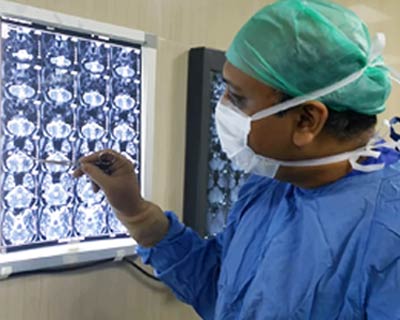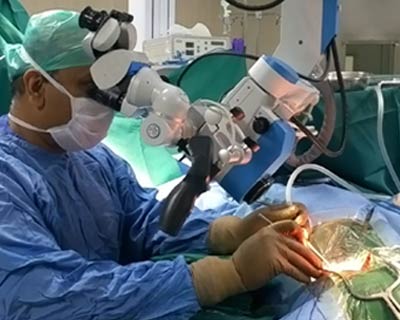Dr. Jaydev Panchwagh’s Work
A few of the research papers he wrote during his formative years as a neurosurgeon include following topics:
- Efficacy and value of stereotactic computer-guided neurosurgery.
- Cervical Spondylotic Myelopathy- Surgery by anterior v/s posterior approach.
- Importance of the A1 perforators in the clipping of Acom cerebrovascular aneurysms.
For the last decade, he has been keenly interested in the field of Microvascular Decompression for Hemifacial Spasms, Glossopharyngeal Neuralgia and Trigeminal Neuralgia. He have handled more than 850 cases of trigeminal neuralgia, which is one of the largest series in India.
Another field on which he has focused has been complex brain tumours inclusive of giant pituitary tumours, C-P angle tumours, gliomas and meningiomas.
When he started performing endoscopic third ventriculostomy in Pune for the first time in 2001, the procedure was still in its very early years in India and in Maharashtra. Endoscopic brain surgery has rapidly progressed since.
While pursuing his super-specialisation course in KEM, Mumbai, he had carried out research on the cranio-vertebral fixation techniques and surgery for cervical spondylosis. And he has continued doing so for the past 18 years, as this field of work is challenging, with good results in expert hands.
Spinal neurosurgery or neurospinal surgery, which include lumbar and cervical spondylosis, Rheumatoid arthritis-related spine problems, Spinal tuberculosis ( spinal Koch’s), pathological and traumatic vertebral fractures, Cervical and lumbar canal stenosis, Radiculopathies, Sciatica etc are all different areas in which he has operated in considerable numbers, with results comparable to renowned international surgeons. He has performed more than 5000 spinal surgeries with a high success rate of 97%.
In the last four years he has concentrated on endoscopic lumbar spinal surgery, also known as the postero- lateral endoscopy or stitchless spine surgery, with excellent outcomes.


List of diseases that are treated by him / Surgeries performed by Dr. Jayadev Panchawagh
Back Pain and Neck Pain
Pain in the low back & neck are very common. Causes could range from simple sprains to osteoporosis or as complex as spinal ( intradural/ extradural) tumours.
Cervical spondylosis
Can present with plain muscle spasm, pain or severe Myelopathy & Radiculopathy. Needs detailed neurosurgical examination, imaging and proper decision making.
Neurogenic claudication
Pain, numbness, heaviness and in later stages, weakness in the lower limbs- on walking for a certain distance.
Sciatica
Very common symptom. Causes can vary from sacroiliac joint pathology, fact joint inflammation, pyriformis syndrome, viral Radiculopathy to frank nerve root compression due to disc herniation or lateral gutter stenosis. Needs proper evaluation & decision making. Neurospine-rehab program or minimally invasive spine surgery.
Spondylolisthesis
Meaning slippage of one vertebra over the other it can cause severe low backpain & pain in lower limbs. Has four causative subtypes. Needs spinal flexors strengthening based rehab program in initial stages.
In advanced stages, needs surgical decompression, fixation & fusion.
Osteoporosis
May present with only back pain or lead to collapse and fractures of the vertebral bodies. Needs comprehensive Neuroendocrine work-up & treatment in initial stages and cement vertebroplasty or balloon kyphoplasty in later stages. These are technically very simple but effective procedures.
Kyphoscoliosis
Needs comprehensive neuro-evaluation to find the exact cause & then the treatment for correction depending on the result. With modern equipments, long segment fixation fusions can be carried out.
Tuberculosis of the spine
Very debilitating problem. Needs surgical intervention in the later stages.
Intradural tumours ( Extra & Intramedullary)
May be located in a very crucial locations and need safe & complete micro-neurosurgical removal. A real neurosurgical challenge, sometimes more difficult than brain surgery.
Tethered cord syndrome
Spinal cord, under tension like a rubber band needs release to restore its functions usually a childhood disease but there is an adult variety as well.
Craniovertebral junction problems
Perhaps the most difficult spinal problems to address..... Atlantoaxial dislocation, Basilar invagination, tumours at the Cranio-vertebral junction, Traumatic fracture dislocations.
Spinal Trauma
Spinal trauma which may or may not include spinal cord injury. If managed in time and with precision, the treatment results are generally rewarding.
Spinal Arteriovanous Malformation
Need careful evaluation and multimodality management....including careful neurosurgical excision.
Brain Tumours
Includes both malignant and benign tumours like gliomas of different grades, glioblastomas, meningiomas, ependymomas, metastases, lymphomas, pituitary adenomas, intra-ventricular tumours…..and many more. Both craniotomy and excision or stereotactic biopsy are possible.
Intracranial Aneurysms/ Arterio-Venous Malformations( AVMs)
Patient presenting with ‘the worst headache of my life’… diagnosis from MR/CT Angiography to DSA, followed by either clipping or coiling.
Micro-Vascular Decompression
Done for either Trigeminal Neuralgia, Hemifacial spasm, or Glossopharyngeal neuralgia.
Hydrocephalus
Also known as water in the brain… treated with Ventriculo-Peritoneal (VP) shunt or Endoscopic Third Ventriculostomy (ETV).
Arnold-Chiari Malformation, Intracranial bleeds/ Haemorrhage, extra-dural or sub dural Haematomas
The list is long and exhaustive…




